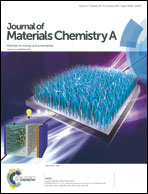Composite β-AgVO3@V1.65+V0.44+O4.8 hydrogels and xerogels for iodide capture†
Abstract
Herein, we report on the study of silver vanadium oxide (β-AgVO3) and slightly reduced vanadium oxide (V1.65+V0.44+O4.8) composite hydrogels, which were synthesized under ambient conditions using a mixture of two solutions. Acidification of the reaction media plays a crucial role in the chemical and physical properties of the hydrogels. The non-covalent cross linked three dimensional network of silver vanadium oxide and vanadium oxide nano-ribbons traps water thus stabilizing the gel form of the materials. Xerogels of the selected materials were produced by drying the hydrogels at 70 °C. The morphology and composition of the nano-ribbons were studied using scanning (SEM) and transmission (TEM) electron microscopy and EDX and EELS compositional analyses of selected areas and punctual microanalyses. In addition, the three dimensional reconstruction of a single nano-ribbon was carried out using electron tomography. Electron paramagnetic resonance (EPR), X-ray photoelectron spectroscopy (XPS) and double titration chemical analyses together with inductively coupled plasma mass spectroscopy (ICP-AES) chemical analyses allowed the proposal of average chemical formulas and vanadium oxidation state. EPR spectroscopy and magnetic susceptibility measurements confirm the existence of a secondary slightly reduced vanadium oxide within the silver vanadium oxide gels jellified under acidic conditions. The micro and mesoporosity of the xerogels were studied using N2 adsorption isotherms, which reveal different porous structures depending on the synthetic conditions. Finally, due to their porous and reactive nature, the hydrogels, organogels and xerogels were tested against methylene blue, crystal violet and iodide adsorption.


 Please wait while we load your content...
Please wait while we load your content...